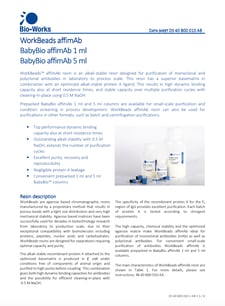Subscribe to the blog
mAb Purification – an overview of the essentials
Apr 24, 2019 11:26:15 AM / The Bio-Works Team
Five of the top ten best selling drugs in 2017 were mAbs and the global mAbs market is expected to reach USD 219 billion by the end of 2023. The mAbs entering the clinic today are highly engineered and are presenting new challenges in purification. When patients are treated repeatedly with high doses and over long periods, the accumulative effects of impurities can be substantial, so the purity requirements of mAb drugs are very stringent.
We've summarized some of the essentials of mAb purification to give you a quick and broad overview of this fast-growing and exciting field.
Table of contents
Five of the top ten best-selling drugs are mAbs
MAb purification presents a challenge
What is mAb purity worth? Some industry numbers
How pure does your mAb actually have to be?
mAb purity vs. yield vs. speed vs. cost
There are some critical factors in mAb purification
Protein expressionHost cell protein removal
DNA removal
Chromatin removal
Endotoxin removal
Cleaning in place
Guard column
What characterizes an efficient protein A resin for mAbs?
Cell harvesting
Capture, enhancement, polishing
Ion exchange chromatography
Affinity chromatography
In-process control measures critical process parameters, CPPs
Quality by Design links the process to the patient
Pricing pressures are the new norm for the pharmaceutical industry
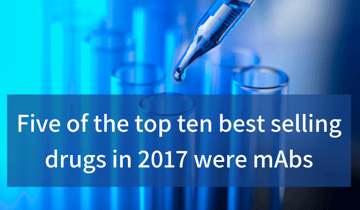 Biotherapeutics (or biologics) comprise the fastest-growing sector in the pharmaceutical industry, with total revenues reaching up to $231.2 billion in 2017. Today there are more than 3000 biologics on the market and the majority of bio-pharmaceuticals in clinical development in the US and the EU are mAb products.
Biotherapeutics (or biologics) comprise the fastest-growing sector in the pharmaceutical industry, with total revenues reaching up to $231.2 billion in 2017. Today there are more than 3000 biologics on the market and the majority of bio-pharmaceuticals in clinical development in the US and the EU are mAb products.
By far the most sold drug, all classes, in 2018 (with sales of $19.936 billion) was HumiraTM, aka, adalimumab, which is an anti-TNF alpha mAb.
In fact, five of the top ten best selling drugs were mAbs in 2017-2018.
The biopharmaceutical industry’s intense focus on the development of antibody therapeutics, and particularly those for cancer, is unabated in 2019.
According to Antibodies to watch, the rate of clinical entry for antibody therapeutics so far in 2019 is similar to that observed in 2018 (~10 per month). The trend toward development of antibodies as treatments for cancer is also quite similar. Of the 2019 cohort so far identified, 79% are for cancer.
Of the 59 new molecular entities approved by the FDA in 2018, for example, 20% were antibodies.
The ability to bind to specific targets with high specificity and affinity has contributed to the explosive growth of mAbs over the last 20 years. mAbs have been approved for a wide range of indications in oncology, autoimmune disorders and rare disease indications.
According to Zion Market Research, the global mAbs market will reach USD 219 billion by the end of 2023. The market growth was much higher than expected only a few years ago, and even this number might be surpassed as we approach 2023.
Read more about three market changes that will impact the production of mAbs
Mab purification presents a challenge
Biopharmaceuticals are large substances with complex and sensitive structures. They are more difficult to purify and analyze than the traditional small molecule drugs. They tend to aggregate and break down and since they are produced in various types of cells, they need to be separated from as much as possible of the cellular material as a first part of their purification.
The mAbs entering the clinic today are highly engineered with an increasing complexity, and a growing variety of recombinant cell systems are used for their manufacture. They are presenting new challenges in purification.
What is mAb purity worth? Some industry numbers
There are several factors contributing to the growth of the mAb therapeutics market, for example:
- Increased prevalence of autoimmune diseases and cancer.
- A growing middle class in emerging markets demanding new treatments.
- Patent cliff – new players coming into the market, offering biosimilars.
- Increased awareness among patients and doctors of different treatment alternatives.
You can find a little more here
The questions for a manufacturer entering the market, with an innovative product or a biosimilar, are – how big is the market and what market share can I achieve? A “blockbuster” original mAb product can have annual sales in excess of 1 billion USD, but it is unlikely that any company entering the market today will achieve such sales levels, unless the product is uniquely successful for a serious and common illness (which will always be a possibility).
The question of purity is of utmost importance for success and its value is best understood by considering the consequences of an impurity contaminating the product. In the best-case scenario, this would be detected prior to product release and lead to either batch rejection or re-working the batch’s purification (this second option might not be available, however, depending on the way the process was developed and documented). In the worst-case scenario, the batch could reach patients and lead to side effects that would almost certainly have a major impact on the product’s and possibly the whole company’s future. The potential loss of value to the company could thus be enormous.
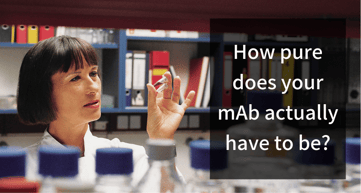 When it comes to biotherapeutics, pure means that the product is pure enough for the application in question, not that the product is 100 percent pure. More precisely, it should not contain certain unwanted substances, such as DNA, toxins, or substances that could cause an immune reaction. However, purification processes are expensive, so it is not wise to purify the product more than is necessary.
When it comes to biotherapeutics, pure means that the product is pure enough for the application in question, not that the product is 100 percent pure. More precisely, it should not contain certain unwanted substances, such as DNA, toxins, or substances that could cause an immune reaction. However, purification processes are expensive, so it is not wise to purify the product more than is necessary.
Read our first Tips and Tricks blog post for some general pointers.
When patients are treated repeatedly with high doses and over long periods, the accumulative effects of impurities can be substantial. Therefore, mAbs must be very clean – ultra pure – compared to, for example, vaccines that are only injected once or twice over the lifetime of a patient. With mAbs, you need to go below the level where certain defined impurities are no longer detectable or below specified levels, such as less than a 100 ng/dose for DNA (according to WHO).
mAb purity vs. yield vs. speed vs. cost
With mAb purification there is always a trade-off between purity, yield, speed and costs. The protein A purification, though the most efficient step in the purification process, is also the costliest step, which means that strategies that save or expand the life span of protein A are desirable.
Speeding up the process, will generally result in the loss of something; either purity or yield. A faster process might also be more costly since it might require larger amounts of chromatography resins (i.e. larger columns), or more advanced and expensive resins.
Going through a step at a faster pace could result in an increase in yield and purity, as there is less risk that the product degrades during the process. On balance, however, maximizing yield will take longer and may cause a problem with purity, because you do not want to discard any of the mAb, even if it is slightly contaminated.
There are some critical factors in mAb purification
Protein expression
To produce large biomolecules intended for use as biopharmaceuticals you may need to manipulate a living cell into making the protein in question. In that case. the starting material could be a mammalian cell culture or a bacterial fermentation. For a naturally occurring product, it could be an extract from a plant or other organism. It is often a challenge to make or find a source with a high expression level, and this may also introduce additional challenges, such as very high cell densities, which may cause problems in harvesting the product, and higher concentrations of impurities that impact separation steps downstream. The expression level of the cell or bacteria is measured in grams of target product per liter of feed, g/L.
The protein is then purified in the downstream process, using filtration and chromatography.
Host cell protein removal
Host cell protein, HCP, removal (as well as DNA removal, see below) is an essential step in downstream purification from the host cell material used to produce your target molecule. There are several methods for HCP removal, mainly filtration and chromatography. Protein A chromatography can be viewed as the backbone of the purification process as it binds mAbs, and in general nothing else. However, protein A purification is also the most costly step. A pre-column, that can remove some of the HCPs (and DNA), could therefore be a valuable tool to reduce the burden on the protein A column and increase its life span.
DNA removal
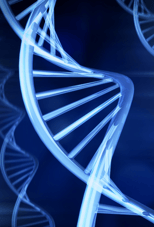 DNA will also be present in your material (see HCP removal above), as cell death and cell lysis will cause the cells to release their DNA. Protein A chromatography will remove the DNA, as protein A binds mAbs but not DNA (or HCPs). You might also want to consider introducing a pre-column that will remove some of the DNA beforehand.
DNA will also be present in your material (see HCP removal above), as cell death and cell lysis will cause the cells to release their DNA. Protein A chromatography will remove the DNA, as protein A binds mAbs but not DNA (or HCPs). You might also want to consider introducing a pre-column that will remove some of the DNA beforehand.
One way of doing that is to use a multimodal ligand, which is positively charged and has a high binding capacity for so-called bulk impurities, such as DNA. DNA is negatively charged and will thus adsorb to the ligand, whereas mAbs, which are often positively charged under the operating conditions used, will be left in the unbound flow-through fractions.
Chromatin removal
Chromatin is a large complex of DNA packed around specific proteins that compact the DNA in the cell nucleus. Just as with HCP and DNA, chromatin can damage the protein A column. As chromatin is also negatively charged, a pre-column with a positively charged multimodal ligand might be useful to remove some of the chromatin without affecting the mAbs (see DNA removal).
Endotoxin removal
Endotoxins are toxins from bacteria that can cause severe reactions if injected into a patient and which must therefore be removed from the product. When a mammalian cell culture is used for mAb production, bacteria should not be present and hence there should be no endotoxins in your cell harvest. However, in the manufacturing process there is always a risk of bioburden – an unwanted source of bacteria, which will challenge the purification process. Similar to HCP, DNA and chromatin removal, eliminating endotoxins in a pre-column could be a cost-efficient strategy. The issue is of course very relevant in production systems that express proteins in bacteria, such as the gram-negative bacterium Escherichia coli (E. coli).
Cleaning in place
The backbone of the purification process is the valuable protein A column, which needs to be protected. To prolong the life span of the protein A column, it can be cleaned after a certain number of cycles in order to remove impurities that are attached to the column. Cleaning in place, CIP, allows you to avoid emptying the column by instead pumping a concentrated solution of sodium hydroxide through it to remove the bound impurities, saving a lot of work. Sodium hydroxide is the most common agent for CIP of the protein A column.
Depending on the design of your process, you can perform less CIP if more impurities are removed early in the process during harvesting or through the use of a pre-column.
Guard column
A guard column is the same thing as a pre-column (see HCP, DNA chromatin and endotoxin removal), i.e. a column that is introduced early in the purification process to guard the following chromatography step or the rest of the downstream process. The term guard column is a well-known concept in analytical chromatography. The guard column protects the analytical column from impurities that may be present in samples.
Read much more about the concept of using a guard column in this way
What characterizes an efficient protein A resin for mAbs?
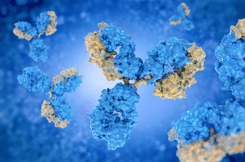 There are several characteristics of an efficient protein A resin that are fundamental to your mAb purification process. Firstly, the resin should have a very high specificity, or selectivity, for mAbs. It should show no binding other than to the target molecule.
There are several characteristics of an efficient protein A resin that are fundamental to your mAb purification process. Firstly, the resin should have a very high specificity, or selectivity, for mAbs. It should show no binding other than to the target molecule.
An efficient resin should also have a high dynamic binding capacity, meaning it can bind large amounts of mAbs in a short time. With a high dynamic binding capacity, you can pump the sample through the column rapidly without losing mAbs in the flow-through.
Another fundamental characteristic is the stability of the resin. The protein A is attached to the resin by chemical bonds and the more stable these bonds are, the more cycles you can run as well as CIPs (the base matrix itself must of course also be stable). A stable resin is thus a resin that can tolerate high concentrations of sodium hydroxide without chemical break down. The number of cycles you can run with the same resin has a huge economic impact.
You should also be able to recover your product, or target molecule, from the resin, by reducing the pH-value of the eluent flowing through the column. As the pH-value is reduced, the bonds between the mAb and protein A are broken and, with an efficient resin, this should result in almost pure mAbs and a high yield.
Read more about how to recognize an efficient protein A resin for mABs
The steps in mAb purification
Cell harvesting
For mAb production, the most commonly used cell type is the Chinese Hamster Ovary cell, CHO cell. CHOs are programmed to produce specific mAbs and are grown in bioreactors for up to 14 days. During this period, the cells grow and multiply and produce the mAb extracellularly, that is, they release the mAbs into the supernatant, just as immune cells would release antibodies into the bloodstream in a living mammal.
After these 14 days the cells have released the maximum amount of mAbs before they die and start to release enzymes and other substances from within the cell that can damage the mAbs and make purification difficult. There is therefore an optimal point for “harvesting”, steps where cells, cell debris and some bulk impurities are removed from the supernatant, leaving a clear liquid that will not clog the pre-column or protein A column.
Harvesting usually comprises three to four steps, where bulk impurities and particles are removed by various filtration methods and/or centrifugation. As the first steps of the downstream process are generally less expensive compared with steps towards the end of the downstream process, it could be a cost-efficient strategy to include an additional step of purification at this stage, in the form of a guard column, rather than later in the downstream process.
Capture, enhancement, polishing
Capture, enhancement and polishing are terms used to describe protein or mAb purification in an industrial context. The whole purification process usually comprises five or more steps, if all unit operations are included, where capture is the first phase. In this typical purification strategy, capture of the target molecule takes place after harvesting, after you have clarified the feed and removed some bulk impurities, but the product is still mixed with large amounts of many impurities and potentially degrading contaminants, as well as often being rather dilute. In the next phase, enhancement, you use chromatography to separate your target molecule from various remaining impurities, including HCPs and DNA. The last phase of the purification process is called polishing. Polishing takes place downstream of the protein A column, where the last traces of impurities, often rather challenging ones, are removed from the mAbs to produce the bulk drug product.
Ion exchange chromatography
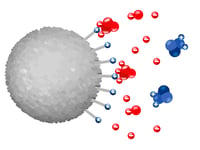 For the guard column, multimodal ion exchange chromatography is used to remove HCP and other impurities. The guard column has a multimodal ligand with charge properties, but also hydrophobic properties. The positively charged ligands bind DNA and HCPs, and, due to their hydrophobic properties, lipids from the cell membranes are also adsorbed to the ligand.
For the guard column, multimodal ion exchange chromatography is used to remove HCP and other impurities. The guard column has a multimodal ligand with charge properties, but also hydrophobic properties. The positively charged ligands bind DNA and HCPs, and, due to their hydrophobic properties, lipids from the cell membranes are also adsorbed to the ligand.
Ion exchange chromatography steps are also often used after the protein A step to remove the last remaining impurities.
Affinity chromatography
 Affinity chromatography is the most specific and powerful chromatography method, where a target molecule can be separated from other unwanted material.
Affinity chromatography is the most specific and powerful chromatography method, where a target molecule can be separated from other unwanted material.
Affinity chromatography is based on finding a suitable ligand that has an extremely high selectivity for your target molecule. The ligands are attached to a chromatography base matrix in such a way as to produce a high dynamic binding capacity, which is one of the characteristics of an efficient protein A resin for mAbs (see above). The resin must also be stable and able to resist the high concentrations of sodium hydroxide used for CIP.
With affinity chromatography, you can achieve a very high degree of purification in just one step.
In-process control measures critical process parameters, CPPs
New technologies are now offering a dynamic adaptation of the process, throughout production, reducing reliance on final QC tests and costs associated with late recognition of batch failures.
Developing a pure protein has a lot to do with process control. As mAbs are produced in batches, natural variability of the material, as well as variations in operations and other disturbances, can cause batch-to-batch variability. Traditional product-release quality controls, QCs, are based on tests of the final products, when it is too late to understand and repair batch-to-batch variations.
In-process control measures Critical Process Parameters, CPPs, during manufacturing. By including in-process analyses the process can be adjusted at an early stage, if needed, and batch failures can be avoided. In-process control also complies with the FDA guidelines regarding the implementation of Process Analytical Technology, PAT[4].
Read more about in-process control here
Quality by Design links the process to the patient
Besides using new technology for process control, another important methodology for achieving the required and appropriate purity of your mAb is through Quality by Design, QbD.
Quality by Design (QbD) is a science- and risk-based approach, outlined by the International Conference on Harmonization (ICH). The essential element is an understanding of how purity parameters are linked to patient safety and drug efficacy.
A critical component of QbD is understanding the functional relationships between patient needs, product quality attributes that are linked to safety and efficacy, analytical capabilities, and the manufacturing process. Quality is built into the product by means of process understanding and product knowledge.
Using QbD, the impact of materials and process parameters on product quality are well understood and sources of variability are well-known and controlled. In contrast, traditional pharmaceutical manufacturing has relied heavily on end-product testing and typically lacks the flexibility needed to respond to unexpected variation.
Read more about QbD in purifying mAbs here
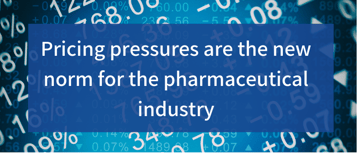 Drug prices are being forced down by three main factors: government pressure, the rise of generics and so-called biosimilars and patent expiry. The high price of biopharmaceuticals is expected to lead governments to actively promote the use of generics and biosimilars, putting further pressure on prices. Market growth of the competing biosimilars is expected to be further facilitated by the loss of patent protection for the best-selling biopharmaceuticals. Read more…
Drug prices are being forced down by three main factors: government pressure, the rise of generics and so-called biosimilars and patent expiry. The high price of biopharmaceuticals is expected to lead governments to actively promote the use of generics and biosimilars, putting further pressure on prices. Market growth of the competing biosimilars is expected to be further facilitated by the loss of patent protection for the best-selling biopharmaceuticals. Read more…
Savings in time and costs are therefore higher on the agenda of production process planning than ever before. There are some immediate means of cost reduction that could help a bioprocess become more sustainable. Amongst these are employing methods to get the most out of chromatography resins.
In the purification of mAbs, the costliest step is affinity chromatography. Affinity chromatography is the backbone of the purification process, which, in a single step, generates high purity and, in most cases, high yield. The protein A column is not only the most expensive tool but will typically be used at the start of the purification process, when the feed is full of impurities, so a wise strategy would be to try to extend its life span.
It might make sense to remove a lot of impurities before affinity chromatography in order to protect the protein A column and reduce the need for cleaning in place (CIP). This could all be achieved by using a guard column.
Read more about optimizing mAb purification in this way
Read more about the challenge of process economy
High dynamic binding capacity – the key to improved process economy
A high flow rate will speed up your purification process. There is however no point in using a high flow rate if your target molecule does not have the time to bind to the resin. A high dynamic binding capacity is thus an important measurable characteristic of an efficient protein A resin for mAbs (see A novel protein A-based resin for optimized purification of antibodies).
With a high dynamic binding capacity, you can bind more mAbs per ml of resin in real life (expressed as grams per liter of resin in industrial processes). You can thus use smaller columns and less resin to bind the same amount of mAbs, as well as needing smaller buffer vessels, which, in the manufacturing set-up, will decrease your footprint. Smaller columns can also have unexpected benefits, such as shortening the time for cleaning-in-place. In fact, just about everything that costs money will be impacted by a high dynamic binding capacity – column sizes, resin volumes, buffer volumes, cleaning agent volumes, equipment footprints, processing times, etc.
High dynamic binding capacity, allowing short residence times, is thus the most important key to improving your process economy. But, as in most things in real life, there can be trade-offs.
Read more about high binding capacity here
Optimizing purity of mAbs
Designing an optimal mAb purification process includes applying the most appropriate purification steps and using excellent purification tools, as well as appropriate analytical methods.
WorkBeads™ 40 TREN
 Workbeads 40 TREN is a new tool for purification of mAbs that can be used both upstream, as a guard column, or after the protein A column.
Workbeads 40 TREN is a new tool for purification of mAbs that can be used both upstream, as a guard column, or after the protein A column.
Workbeads 40 TREN is an agarose-based multimodal ion exchange chromatography resin with a ligand that is positively charged below pH 9. It has been demonstrated to efficiently remove impurities such as chromatin complexes, endotoxins, and HCPs (Nian et al., J. Chromatogr. A, 1431 (2016) 1-7; Chen et al., J. Biotechnol., 236 (2016) 128-140). Early removal of these impurities will reduce excessive burden on the protein A column and thereby extend its life span.
WorkBeads from Bio-Works are manufactured using a proprietary method that results in porous beads with a tight size distribution and very high mechanical stability. Agarose-based matrices have been successfully used for decades in biotechnology purification, from research scale to production scale, due to their exceptional compatibility with biomolecules, including proteins, peptides, nucleic acids, and carbohydrates. WorkBeads resins are designed for separations requiring optimal capacity and purity.
BabyBio™ TREN 1 and 5 ml
BabyBio TREN are ready-to-use prepacked columns with WorkBeads 40 TREN resin. BabyBio TREN is available in two column sizes, 1 ml and 5 ml.
WorkBeads affimAb
WorkBeads affimAb is an agarose-based alkali-stable protein A resin for mAb purification, which can be used from lab scale to process scale. Workbeads affimAb is a high-binding resin that has been shown to produce a higher purity of eluted mAbs from cell extracts compared to the present market leading resin. The high binding capacity allows for high flow rates, with the resin binding more than 40 mg IgG/ml resin, with residence times as short as 2.5 min.
BabyBio affimAb 1 and 5 ml
BabyBio affimAb are ready-to-use prepacked columns with WorkBeads affimAb resin. BabyBio affimAb is available in two column sizes, 1 ml and 5 ml.
Read a summary of the technology behind these new resins
How Bio-Works resins help you get mAb purity right
Bio-Works is a Swedish company with research, development and productions facilities in Uppsala, north of Stockholm.
Our aim is to provide high quality products that help our customers streamline and optimize their purification processes and save costs. The products are optimized for purification in several categories such as size exclusion, ion exchange and affinity purification – from small lab samples to industrial scale production. With our patented manufacturing method we produce the “next generation resins” – our agarose-based WorkBeads.
Bio-Works was founded by four leading experts in protein purification and many of us have previously worked for Pharmacia and GE Healthcare. We have as much passion for protein purification as we have experience in the field. We believe that the best recipe for great service and outstanding quality is a mixture of innovative thinking and long experience.
All product and company names marked with ™ are trademarks or registered trademarks of Bio-Works or of the respective trademark holders. Use by Bio-Works of trademarks of other holders does not imply any affiliation with or endorsement by them.
